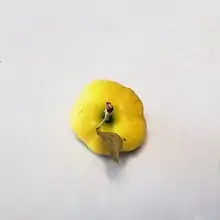| Api Etoile | |
|---|---|
 Top view of an immature fruit showing yellow coloration and the beginning of a distinct pentagonal shape. | |
| Genus | Malus |
| Origin | 1600s in Switzerland[1][2] or France[3][4] |
The Api Etoile, also known as Star Apple,[5] Pomme Etoilée,[5] or Star Lady Apple,[2][6] is an apple cultivar notable for its five prominent knobs giving it the appearance of a star. It falls into the Api family of apple cultivars.[5]
The Api Etoile is a rare cultivar. It is cultivated at a few specialty orchards.[3]
Characteristics
The signature characteristic of the Api Etoile is its shape. The five ovaries of the apple form distinct knobs giving the apple the appearance of a rounded star. The apple has light green and pink skin. Its thick and waxy skin protects the flesh from moisture making it keep longer than other apples.[2]
History

The Api Etoile was first described in the 17th century by the Swiss botanist J. Bauhin in Historia plantarum universalis under the name Pomum Pentagonum (transl. pentagonal apple).
After Bauhin's death in 1613 the fruit would be cultivated in Italy and in the early 18th century it was cultivated by the Carthusians of Paris.[7]
References
- ↑ Whealy, Kent; Thuente, Joanne (2001). Fruit, Berry, and Nut Inventory (3 ed.). Seed Savers Exchange. p. 53. ISBN 1882424573.
- 1 2 3 Jacobsen, Rowan. Apples of Uncommon Character: Heirlooms, Modern Classics, and Little-Known Wonders.
- 1 2 Anne Ewbank. "Api Etoile Apple". Atlas Obscura. Retrieved December 30, 2020.
- ↑ Anne Ewbank (January 6, 2020). "Around the World in Rare and Beautiful Apples". Atlas Obscura. Retrieved December 30, 2020.
- 1 2 3 Scott, John (1873). Scott's Orchardist: Or Catalogue of Fruits Cultivated at Merriott, Somerset. H.M. Pollett, horticultural steam printer. p. 122.
- ↑ Downing, Andrew (1876). The Fruits and Fruit Trees of America (14 ed.). OL 7115805M.
- 1 2 Leroy, André (1867). Dictionnaire de pomologie, contenant l'histoire, la description, la figure des fruits anciens et des fruits modernes les plus généralement connus et cultivés (in French). Vol. 3. p. 70. OL 24162740M.
- ↑ Bauhin, Jean (1650). Historia plantarum universalis [Universal History of Plants] (in Latin). Vol. 1. Ebroduni. p. 10. OL 22238516M.